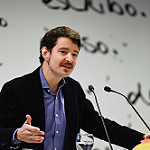An innovative large-scale action research in education
The Massachusetts Institute of Technology hosted the LINC Conference an international gathering of individuals and organizations to talk about and share best practices on current digital learning topics. The LINC event was arranged by MIT’s Office of Digital Learning.The 2016 Conference theme was on Digital Inclusion: Transforming Education through Technology. LINC 2016 emphasizes the following topics:
- Providing Quality Education at Scale
- Bridging the Education Divide
- Understanding Learning Engineering and Incorporating Key Fundamentals
- Developing Tools for the Digital Learning Experience
- Recognizing the Role of Digital Learning for Students of All Ages
Speakers represented the global digital learning community’s key organizations and individuals, as well as feature MIT’s central digital learning initiatives.
A group from the Center for Research – Ceibal Foundation and New Pedagogies for Deep Learning in Uruguay (Red Global de Aprendizaje) prepared a collaborative papers (co written by Claudia Brovetto, Fiorella Gago and Cristobal Cobo) which was presented during the summit. The work’s title was: ‘A Global Network for Deep Learning: the Case of Uruguay’.
Here the paper’s abstract:
The aim of this paper is to describe an innovative large-scale action research in the field of education. This paper illustrates a unique sample of a global network of schools working together as a “living lab” to test, implement and improve innovative pedagogical practices in seven different countries (clusters). This experience can be regarded as a disruptive experiment from the methodological (i.e. network of schools), pedagogical (i.e. learning by creating) and accountability perspective (i.e. novel ways of assessing learning outcomes). This global network allocates special relevance to the cultural and contextual specificities of each member. This paper focuses on the Uruguayan case, the only non-developed partner country, which is working in incorporating up to 2,800 schools in this global network by the end of 2019. After providing a background and key figures of the current education system in Uruguay, the authors describe the outcomes of this experience so far (2013- 2016) and highlight some of the expected achievements and instruments to assess the second phase of this experience (2016-2019), with special emphasis in the design of new metrics and the adoption of new assessment tools. After stating the conclusions, the paper points out the limitations and further questions to be explored along the implementation of this global experiment in education.
Some of the elements that make this Uruguayan initiative particular are:
- Scale: As known by previous studies in many cases innovation in education is conducted through pilot experiences, which might be difficult to scale up at a national level. In other cases this interventions are implemented in an ideal context or highly controlled educational environment (e.g. Small schools or a well off institution). However in this case the context is different, during the first year of field-work implementation (2015), the project included 100 schools. In 2016 the project doubled the number of schools to 200, and the goal is to expand progressively to include the 100% of the public schools (2800) in the next four years.
- Multiple innovation fluxes: Although the project was designed by a group of experts in pedagogy, the implementation of the project requires the development of phases of innovation. This innovative process needs to be adapted and adopted from the foreign context and translated into national and local practices. In this case the experience integrates a complex but dynamic set of communities. In other words, in Uruguay different strategies for change can be found, top-down innovations which come from the government (ANEP, Plan Ceibal, Ministry of education, etc.) to the schools; as well as bottom-up innovations which move from schools and local communities who are part of this network, and open innovation, which implies innovation among different schools regardless if they are in the country or part of this global network.
- An ‘invisible’ role of technology: Plan Ceibal was created in 2007 as a digital inclusion program to provide technology to all students in Uruguay. Likewise, information technologies are adopted by the NPDL to leverage the power of digital tools in a innovative but also flexible way. However, the integration of technology is considered a tacit capacity (the training on digital tools is not considered a priority) but the school-to-school as well as country-to-country exchanges of those involved in NPDL play a key role during the whole experience. Technologies are chosen by students (not by teachers) only when they add value to their learning experience. Students are allowed to adopt what they consider relevant such as programming, robotic, video-conferencing, social networks, among others.
- Teachers as Students: The NPDL aims to generate a whole ecosystem of change by integrating a holistic systemic approach of the project, by implementing long term processes and enabling intra – inter connections between participant institutions. The NPDL cluster assembles top down policies along with bottom up feedback, which works as a two ways negotiation stream between educational priorities on the political agenda and feedback from different institutional levels.
A Global Network for Deep Learning: the Case of Uruguay from Cristóbal Cobo <cross-post>
"Technology is not the goal" Dr. Cristobal Cobo.#MITLINC pic.twitter.com/oyNVWzUP1D
— Mike Bukhtoyarov (@MikeBukhtoyarov) 23 de mayo de 2016

Posted in aprendizaje colaborativo, Education and ICT, futuro, innovación, sociedad de los conocimientos on Jul 18, 2016




